Point of convergence. A musical and dance voyage.
Point of Convergence – A Musical and Dance Voyage developed by Arsenio Diaz – is a program that recognizes and respects cultural differences by promoting the understanding of ethnic heritage through music and dance. The main purpose of this program is to bring awareness about the need to preserve heritage, traditions, and culture.
We want to engage our community through a project that can connect people to their own culture and that of other cultures, which even though they have a strong presence in our communities, they are often not promoted in mainstream artistic offerings. Additionally, through the showcase of traditional music and dance, we are advocating for the recognition and respect of cultural differences while encouraging the understanding of unique, cultural and ethnic heritages.
It is undeniable that art is significant to society. The celebration of one’s culture and art have a direct and positive effect on the fundamental sense of self, with perhaps one of its greatest attributes being the ability to unite people across the spectrum of humanity. Art inspires society to cope and even overcome difficulties. During a time when the world has been affected by a global pandemic that has caused direct human connection to be placed on an unforeseeable hold, we feel that this performance more than ever is needed to educate, build bridges between cultures, inspire and unite people across the multicultural communities of South Florida.
#1 Yaman (Alap)
#2 Baul (Folk song)
#3 Shangó
#4 Shiva
#5 Guaguancó (potpourri)
#6 Masters of percussion
#7 Almendra (Danzón)
#8 Conga
1. Raga Yaman (Alap): “Ragas are soliloquies and meditations, passionate melodies that draw circles and triangles in a mental space, a geometry of sounds that can turn a room into a fountain, a spring, a pool.” – Octavio Paz.
Raga is a melodic framework for improvisation akin to a melodic mode in Indian classical music. The Raga is a unique and central feature of the classical Indian musical tradition, and as a result has no direct translation to concepts of classical European music. Each Raga is an array of melodic structures with musical motifs, considered in the Indian tradition to have the ability to “color the mind” and affect the emotions of the audience.
The Raga you will hear today is Yaman, and is considered to be one of the most fundamental ragas in Hindustani tradition. It is a Raga that should be performed during the first quarter of the night. From this Raga, we will be only interpreting a short Alap section. Alap is the opening section of a typical North Indian classical performance. It is a form of melodic improvisation that introduces and develops a Raga. It is unmetered, improvised (within the notes of the raga), and unaccompanied (except for the tanpura drone).
2. Baul is a mystical song of the Baul community. This is a light instrumental piece in Hindustani classical music, based on a folk or a religious tune. As the Sitar and tabla bring out the beauty of this composition through music, Aparna will enhance this beauty through her facial expressions with her ‘Abhinaya’. She portrays a scenario where the tranquility in nature reminds her of her time spent with her beloved. The sunsetting on the horizon, the cool breeze, fragrance of flowers, the moonlight, everything reminds her of good times she spent with her beloved.
3. Shangó: This piece is a version of the Rezo y Meta de Changó, a ritual dance associated and offered to the Yoruba Orisha (deity) Changó.
This dance, performed by a Changó child to honor and entertain her Orisha father, represents the spirit of the fire, thunder and dance. He is the father of the cowry shell; the warrior orisha with a quick wit and a temper. Rules over lightning, thunder, passion, and drums. He is handsome, but never considered feminine in beauty; he is very masculine. He is the king of kings who loves sex and music. His dance is elegant, opulent, majestic, brave, and sensual. The arm movements describe his “aché” or power to bring lightning to the earth. He was a feared warrior who frightened his enemies by breathing fire though his mouth. He uses a double-bladed “Oshe” or axe to work and fight; his colors are red and white. His representative number is 6, and is syncretized with the catholic saint Santa Bárbara. Changó does not have paths, but has various names acquired while conquering different lands for example, Baralube (the diviner); Alafin (the king of Oyo City); Alaye (who possesses the Osain’s secret).
Afro-Cuban dance: In the Afro-Cuban folkloric tradition, dance is so deeply entwined with music, storytelling, and religion that almost everyone dances, and there’s almost always a reason to be dancing. Most movement in the Afro-Cuban dance tradition comes from the African religion known as Yorùbá, which West Africans continued to practice in Cuba after they were enslaved and forced to work on the island. Practitioners of Yorùbá believe that there are many different expressions of God called Orixás. Each Orixá symbolizes a different part of life or the world around us, and each has a characteristic movement style and “implement,” or tool.
4. Shiva: Shiva is one of the most important gods of the Hindu Holy Trinity. He is the auspicious one, the Lord of Dance, the Lord of the universe. He is The destroyer which leads to recreation. He is worshipped as the presiding deity of the five elements of Nature – Earth, Water, Fire, Air, and Ether. The five elements are the building blocks of everything in Creation, including the human body, and Lord Shiva is the upholder of the five elements. Dance is an important art form in India, and Shiva is believed to be the master of it. Hence is called Nataraja, the cosmic dancer and the Lord of Dance. The rhythm of dance is a metaphor for the balance in the universe which Shiva is believed to hold so masterfully. In this piece, Aparna brings out Shiva’s majestic beauty through her Bharata Natyam dance style where she strikes a delicate balance between her body movements, facial expressions and intricate footwork. This composition will conclude with an amalgamation of dance and complex tabla patterns.
Dance: Bharatanatyam is the oldest classical dance tradition in India. It flourished in the temples and courts of southern India since ancient times. Its style is noted for its fixed upper torso, bent legs and knees flexed combined with spectacular footwork, and a sophisticated vocabulary of sign language based on gestures of hands, eyes, and face muscles. The dance has traditionally been a form of an interpretive narration of mythical legends and spiritual ideas from the Hindu texts. Their hand and facial gestures are codified sign language that recite a legend, spiritual ideas or a religious prayer derived from Hindu Vedic scriptures. The dancer deploys turns or specific body movements to mark punctuations in the story or the entry of a different character in the play or legend being acted out through dance (Abhinaya). The footwork, body language, postures, musical notes, the tones of the vocalist, aesthetics and costumes integrate to express and communicate the underlying text. Bharatanatyam contains at least 20 asanas found in modern yoga. Many of the ancient Shiva sculptures in Hindu temples are the same as the Bharatanatyam dance poses.
5. Guaguancó: is a subgenre of Cuban rumba, combining percussion, voices, and dance. It is one of the most popular styles of rumba that is still danced today. Rumba developed among the different African ethnic groups, primarily from Central and West Africa, who were brought to Cuba as slaves. Guaguancó, like the other rumba styles Yambu and Columbia, developed in the middle 1800’s. Guaguancó is played in 2/4 or 4/4 tempo giving it a moderate to fast tempo.
6. Masters of percussion: The melody of this piece is based on a Punjabi song. The main intention of this piece is to show the skills and expertise of the percussionists playing today.
7. Almendra (Danzón): This piece is a version of the Danzón Almendra composed by Abelardo Valdés around 1938.
The Danzón is the official musical genre and dance of Cuba. The danzón evolved from the Cuban contradanza, or habanera (‘Havana-dance’). The contradanza, which had English and French roots in the country dance and contredanse, was probably introduced to Cuba by the Spanish and the British. In Cuba, the dances of European origin acquired new stylistic features derived from African rhythm and dance to produce a genuine fusion of European and African influences. The danzón was initially regarded as scandalous, especially when it began to be danced by all classes of society.
8. Conga: The term conga refers to the music groups within Cuban comparsas and the music they play. Comparsas are large ensembles of musicians, singers and dancers with a specific costume and choreography who perform in street carnivals of Santiago de Cuba and Havana. Congas Santiagueras include the Suona and have a long history dating back to the 19th century. One element in the comparsas we are showcasing here is the “Farolas” which are large and elaborately decorated processional items on long sticks that are usually carried at the front of the parade in the comparsas and twirled or spun by their carriers, in time to the music.

Tabla: A Tabla is a pair of twin hand drums from the Indian subcontinent, which since the 18th century has been the principal percussion instrument in Hindustani classical music. The tabla consists of two small drums of slightly different sizes and shapes. The smaller drum (daya) is used for creating treble and tonal sounds, while the primary function of the larger drum (bayan) is for producing bass.
Morsing: The Morsing is mainly used in Rajasthan, in the Carnatic music of South India. It consists of a metal ring that forms the frame, and a metal tongue in the middle fixed to the ring at one end. This instrument is played by placing it in front of the teeth with one hand while it is struck using the index finger of the other hand to produce sound. Movement of the player’s tongue and throat while making nasal sounds is used to change the pitch.
Bansuri: The Bansuri is a bamboo flute with no mechanical keys used in Hindustani classical music that is depicted in ancient Buddhist, Hindu, and Jain temple paintings and reliefs, and is common in the iconography of the Hindu god Krishna.
Tumbi: The Tumbi is a traditional one string musical instrument from the Punjab region of India associated with folk music of Punjab and presently very popular in Western Bhangra music.
Batá drums: A Batá drum is a double-headed drum shaped like an hourglass used primarily for religious or semi-religious purposes originating from the land of the Yorùbá located in Nigeria. It is widely used by worshippers of Santería in Cuba. This instrument was introduced to Cuba in the 1800s during the slave-trade in which close to 300,000 Africans were brought to Cuba. The religion and beliefs of the Yorùbá became the basis for what is known as Lukumí (or Santería in Cuba). There are estimated to be at least 140 different toques for the spirits (saints, or santos) and their different manifestations. In Cuba, the batá consists of a set of three tapered cylinders of various sizes.
Congas (drums): The conga drum, also known as tumbadora, is a tall, narrow, single-headed drum from Cuba. Congas are staved like barrels and classified into three types: quinto (lead drum, highest), tres dos or tres golpes (middle), and tumba or salidor (lowest). Congas were originally used in Afro-Cuban musical genres such as conga (hence their name) and rumba, where each drummer would play a single drum. This instrument was developed by Cuban people of African descent during the late 19th or early 20th century
Paila drum: A paila is a Cuban membranophone that consists of a shallow metal casing with a single-headed drum. It initially was used by street bands in the 19th century. They are shallower in shape than single-headed tom-toms, and come in double sets, tuned an octave apart.
Corneta China (Suona): The Suona is a Chinese double-reeded horn used in the folk music of northern China. The suona is also used as a traditional instrument by Cubans in Oriente and Havana, having been introduced by Chinese immigrants during the colonial era. Known locally as corneta china, it is one of the lead instruments in the conga carnival music of Santiago de Cuba since 1915.
Musicians
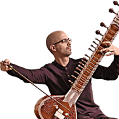 Arsenio Diaz: Received his degree in music and classical guitar in Havana, Cuba. Settled in the USA, he was hired by the Miami Dade College as a classical guitar instructor. He was accepted as student by Bharti D. Chokshi, the executive president of the Association of Performing Arts of India (APAI), to receive lessons of sitar and Indian classical music. He has participated in workshops led by the prestigious musician Alam Khan. Being part of projects like Luyano Band and DJ Ma Non Troppo, he has worked with prestigious institutions such as Miami Dade County Auditorium, TEMS, CCEM, The Historic Asolo theater, Artefactus, Miami International Book Fair, Conecta Miami Arts, The Sacred Space Miami, and MOCA North Miami among others. / Webpage: https://mysticalsitar.net
Arsenio Diaz: Received his degree in music and classical guitar in Havana, Cuba. Settled in the USA, he was hired by the Miami Dade College as a classical guitar instructor. He was accepted as student by Bharti D. Chokshi, the executive president of the Association of Performing Arts of India (APAI), to receive lessons of sitar and Indian classical music. He has participated in workshops led by the prestigious musician Alam Khan. Being part of projects like Luyano Band and DJ Ma Non Troppo, he has worked with prestigious institutions such as Miami Dade County Auditorium, TEMS, CCEM, The Historic Asolo theater, Artefactus, Miami International Book Fair, Conecta Miami Arts, The Sacred Space Miami, and MOCA North Miami among others. / Webpage: https://mysticalsitar.net
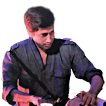 Sudhir Limaye: Received formal training in Delhi and Farrukhabad gharana of Tabla from Late Pandit Suresh Samant from Pune, India. He is a versatile Tabla player with unique ability to accompany in both Hindustani classical, Light Indian and Fusion music formats. A Resident of Boca Raton since 2001, not only he has been actively performing at various local events but has also been actively teaching Tabla for more than 17 years in the area. He has been accompanying various Hindustani classical, semi classical and Bollywood artists travelling to the US, and has been actively collaborating with local jazz artists in the area.
Sudhir Limaye: Received formal training in Delhi and Farrukhabad gharana of Tabla from Late Pandit Suresh Samant from Pune, India. He is a versatile Tabla player with unique ability to accompany in both Hindustani classical, Light Indian and Fusion music formats. A Resident of Boca Raton since 2001, not only he has been actively performing at various local events but has also been actively teaching Tabla for more than 17 years in the area. He has been accompanying various Hindustani classical, semi classical and Bollywood artists travelling to the US, and has been actively collaborating with local jazz artists in the area.
 Eduardo Rodriguez: Originally from Santa Clara, Cuba, Eduardo Rodriguez received his degree from the Amadeo Roldan Music Conservatory in Havana and then settled in the U.S., where he’s become an in-demand percussionist. Now Miami-based, Eduardo has recorded and toured with globally-recognized artists including Gloria Estefan and the Miami Sound Machine, Celia Cruz, Paquito de Rivera, Ricky Martin, Marc Anthony, Carol King, Stevie Wonder, Bacilos, Chayanne, Tito Puente, Barry Gibb, Son by 4, and many others.
Eduardo Rodriguez: Originally from Santa Clara, Cuba, Eduardo Rodriguez received his degree from the Amadeo Roldan Music Conservatory in Havana and then settled in the U.S., where he’s become an in-demand percussionist. Now Miami-based, Eduardo has recorded and toured with globally-recognized artists including Gloria Estefan and the Miami Sound Machine, Celia Cruz, Paquito de Rivera, Ricky Martin, Marc Anthony, Carol King, Stevie Wonder, Bacilos, Chayanne, Tito Puente, Barry Gibb, Son by 4, and many others.
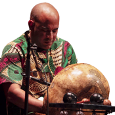 Michael Gil: Studied music and classical guitar in Havana, Cuba. Beyond working as a guitar instructor and composing music for cinema, theater, contemporary dance and other audiovisual performances, he has devoted part of his career to research and study ethnic musical instruments such as berimbau, mbira, kalimba, didgeridoo, talking drum, Jew’s harps and more. Settled in Miami, he created the world music projects “Luyano Band” and “DJ ma non troppo”, and obtained a certified teaching artist with Arts for Learning. He has worked with organizations such as, Musicall, Teatro en Miami Studio, Fundarte, Artefactus, Fundación Cuatro Gatos, Anti Heroes Project, Miami International Book Fair, Conecta Miami Arts, Miami Dade County Auditorium, Adrienne Arsht Center, CCEM, MOCA North Miami, MDC, Miami Children Theater, Museum of Science and Discovery of Fort Lauderdale, Florida International University, Art Basel, Historic Asolo Theater at The Ringling among others. / Webpage: https://thesoundmurai.com/
Michael Gil: Studied music and classical guitar in Havana, Cuba. Beyond working as a guitar instructor and composing music for cinema, theater, contemporary dance and other audiovisual performances, he has devoted part of his career to research and study ethnic musical instruments such as berimbau, mbira, kalimba, didgeridoo, talking drum, Jew’s harps and more. Settled in Miami, he created the world music projects “Luyano Band” and “DJ ma non troppo”, and obtained a certified teaching artist with Arts for Learning. He has worked with organizations such as, Musicall, Teatro en Miami Studio, Fundarte, Artefactus, Fundación Cuatro Gatos, Anti Heroes Project, Miami International Book Fair, Conecta Miami Arts, Miami Dade County Auditorium, Adrienne Arsht Center, CCEM, MOCA North Miami, MDC, Miami Children Theater, Museum of Science and Discovery of Fort Lauderdale, Florida International University, Art Basel, Historic Asolo Theater at The Ringling among others. / Webpage: https://thesoundmurai.com/
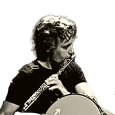 Manuel Clua: Manuel Clua was born in Havana, Cuba where he studied classical music and flute. He worked as a musician for two different theater companies: Teatro Estudio and Giganteria before joining progressive rock band Naranja Mecanica. After moving to Miami, Manuel participated in the musical project Luyano Band and is currently playing with Dj Ma Non Troopo. He also has collaborated with the singer Inez Barlatier. He has worked with prestigious institutions such as Miami Dade County Auditorium, TEMS, CCEM, The Historic Asolo theater, Artefactus, Miami International Book Fair, Conecta Miami Arts, The Sacred Space Miami, and MOCA North Miami among others.
Manuel Clua: Manuel Clua was born in Havana, Cuba where he studied classical music and flute. He worked as a musician for two different theater companies: Teatro Estudio and Giganteria before joining progressive rock band Naranja Mecanica. After moving to Miami, Manuel participated in the musical project Luyano Band and is currently playing with Dj Ma Non Troopo. He also has collaborated with the singer Inez Barlatier. He has worked with prestigious institutions such as Miami Dade County Auditorium, TEMS, CCEM, The Historic Asolo theater, Artefactus, Miami International Book Fair, Conecta Miami Arts, The Sacred Space Miami, and MOCA North Miami among others.
Dancers
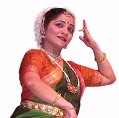 Aparna Matange: Dancer, choreographer, teacher and a singer. Aparna is one of the most accomplished Bharata Natyam dancers, trained in Bharata Natyam under the expert guidance of distinguished Guru Dr. Smt. Sucheta Chapekar. With a performing career of over 2 decades, she has performed extensively in India, United States and abroad in organizations like the National Center of Performing Arts in Mumbai, Kalabharati Music and Arts, Mumbai, various International Universities, and several cultural and charitable organizations across America. Awarded with a scholarship in dance by the Government of India, Aparna has been awarded the title of ‘Singar Mani’ by the Sur Singar Samsad. She also received a special recognition from the University of Bombay, for receiving a Gold Medal in the inter collegiate dance competitions for 3 consecutive years, thus creating a record in itself. She has participated in several theatre and dance ballet productions for ‘Aviskhar Chandrashala’, a theatre institution founded by Smt. Sulabha Deshpande and late Shri. Arvind Deshpande. Aparna also had the honor of participating in 100 theatre performances of the famous Marathi dance drama ‘Durga Zhali Gauri’. Aparna has a Master’s Degree in Life Sciences from the University of Bombay. She is the founder of Nritya Surabhi School of Dance and has been successfully conducting dance classes her banner. / Webpage: http://www.nrityasurabhi.com/aparna-matange
Aparna Matange: Dancer, choreographer, teacher and a singer. Aparna is one of the most accomplished Bharata Natyam dancers, trained in Bharata Natyam under the expert guidance of distinguished Guru Dr. Smt. Sucheta Chapekar. With a performing career of over 2 decades, she has performed extensively in India, United States and abroad in organizations like the National Center of Performing Arts in Mumbai, Kalabharati Music and Arts, Mumbai, various International Universities, and several cultural and charitable organizations across America. Awarded with a scholarship in dance by the Government of India, Aparna has been awarded the title of ‘Singar Mani’ by the Sur Singar Samsad. She also received a special recognition from the University of Bombay, for receiving a Gold Medal in the inter collegiate dance competitions for 3 consecutive years, thus creating a record in itself. She has participated in several theatre and dance ballet productions for ‘Aviskhar Chandrashala’, a theatre institution founded by Smt. Sulabha Deshpande and late Shri. Arvind Deshpande. Aparna also had the honor of participating in 100 theatre performances of the famous Marathi dance drama ‘Durga Zhali Gauri’. Aparna has a Master’s Degree in Life Sciences from the University of Bombay. She is the founder of Nritya Surabhi School of Dance and has been successfully conducting dance classes her banner. / Webpage: http://www.nrityasurabhi.com/aparna-matange
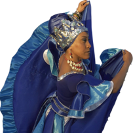 Marisol Blanco: Master Teacher and graduate of Cuba’s prestigious Superior Institute of Arts (ISA) Bachelor of dance teacher from The National School of Arts (ENA). Presently training teachers and all levels in Afro-Cuban Folkloric, Popular/Latin/Caribbean traditional dances around the American Continent and the Diaspora. Professional dancer, teacher, performer and choreographer for more than 25 years. Former member of Cuba’s first female drumming and dance group, “Obini-Bata” with respective recognition and evaluation from the Cuban National Center of Popular Music as Percussion Specialist/Vocalist Master Level. Professionally danced in The Cuban Traditional Dance Company J.J and successfully completed certificates of Art Performance Management, Ethnology, Social Anthropology and Ethno Choreography. Marisol is the owner and director of Sikan Afro-Cuban Dance Project. Earned popularity for her Rumba classes and special Afro-Cuban learning program “HPS” emphasizing the connection between history, percussion, song, step/body expression/technique, philosophy, psychology and methodology knowledge all interactive in her classes. Travels to several countries as an instructor and performer staying active in both dance and teaching careers successfully. / Webpage: http://marisolblanco.com
Marisol Blanco: Master Teacher and graduate of Cuba’s prestigious Superior Institute of Arts (ISA) Bachelor of dance teacher from The National School of Arts (ENA). Presently training teachers and all levels in Afro-Cuban Folkloric, Popular/Latin/Caribbean traditional dances around the American Continent and the Diaspora. Professional dancer, teacher, performer and choreographer for more than 25 years. Former member of Cuba’s first female drumming and dance group, “Obini-Bata” with respective recognition and evaluation from the Cuban National Center of Popular Music as Percussion Specialist/Vocalist Master Level. Professionally danced in The Cuban Traditional Dance Company J.J and successfully completed certificates of Art Performance Management, Ethnology, Social Anthropology and Ethno Choreography. Marisol is the owner and director of Sikan Afro-Cuban Dance Project. Earned popularity for her Rumba classes and special Afro-Cuban learning program “HPS” emphasizing the connection between history, percussion, song, step/body expression/technique, philosophy, psychology and methodology knowledge all interactive in her classes. Travels to several countries as an instructor and performer staying active in both dance and teaching careers successfully. / Webpage: http://marisolblanco.com
Guest Artists
Carlos Ramirez – (Dancer)
Yasser Hector – (Farola carrier)
Delysvell Perez (Meple) – (Farola carrier)
Graham Winick
Ismaray Alonso
Adela Cardelle






